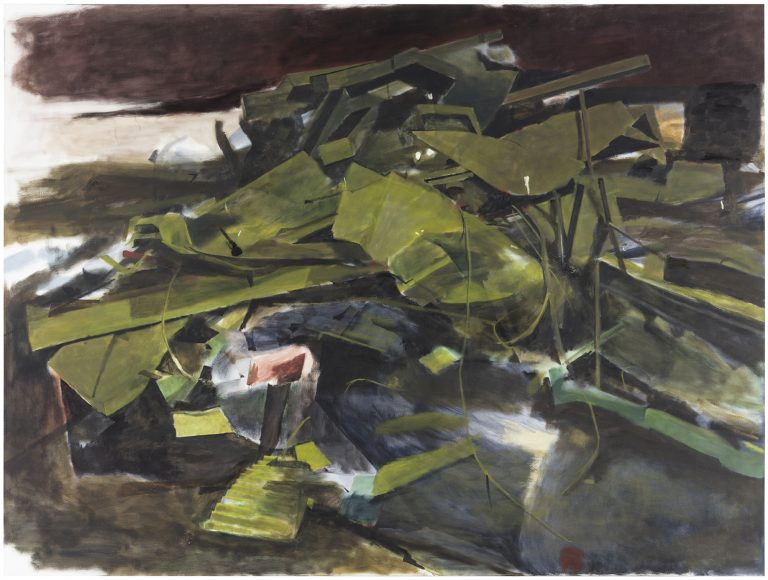An important part of Kohta’s programming is to showcase the five artists who initiated this new kunsthalle for Helsinki three years ago. After Martti Aiha’s exhibition in the early autumn of 2018, the time has now come for Thomas Nyqvist (born in 1955 in Porvoo).
Since he first exhibited in the late 1970s Nyqvist has been well known for his profound engagement with painting as a system of thought, a tradition of knowledge and a practice marked by continuous change. The painted image, and especially painted space, is his medium and his message. For Nyqvist painting is not a small, sealed-off world of its own but a microcosm of more or less manageable format, wide open to the big unknown.
Perhaps lesser known is his interest in lens-based imagery as an alternative ’discipline’ (although this term should be taken with a grain of salt in any art context) for observing and influencing reality, as specialised and demanding as painting. To make photography and painting enrich and challenge each other, Nyqvist has long used his own snapshots as visual sources for meditations in oil on canvas on built and ruined spaces.
This is the first time he displays a selection of analogue and digital photographs, often of industrial buildings being demolished, alongside paintings in larger and smaller formats. The exhibition at Kohta consists of three spaces that cannot be viewed at the same time. Instead the memory of what we have just seen helps amplify what is in front of our eyes.
The largest exhibition space introduces us to four new and rather large paintings, all finished in 2019, in which Nyqvist tries a looser, less representational approach to his photographic sources. A recurrent method, in his larger and smaller paintings alike, is the palimpsest. (The term was first used to describe manuscripts on sheets of parchment scraped almost clean of earlier text.) Nyqvists paints over an earlier image, which is required to give up most of its existence as it enters into dialogue with the new one. Allowing the primed or unprimed canvas to play a part in this becoming increases its complexity.
Overall the larger canvases revive certain formal and visual characteristics of post-war abstract expressionism in the US and its ‘followers’ in the rest of the world. Not least Arshile Gorky is an active reference for Nyqvist, but he also relates to other predecessors in American and European art history. This can also be seen in the titles chosen for the new paintings: The Garden of Earthly Delights(borrowed from Hieronymus Bosch), Fragment of a Fragment, Painting with Zand Building Greyness(paraphrasing Jackson Pollock’s title Ocean Greyness).
The smaller paintings offer more variation in image surface structure, technical execution and colour. Some of them, the palimpsests in particular, are reminiscent of the densely layered painting method invented by the ‘Flemish Primitives’ in the fifteenth century, while others make do with a few simple forms: traces of quick brush strokes on a white background. Others still keep pictorial space open towards the illusion of photographed or filmed reality, for instance with strategically added ‘glimpses of light’, conceivably emitted by a city somewhere in the background. While Nyqvist refrains from clarification and elaboration of detail the the larger paintings, this more limited format seems to grant him more leeway.
A time-honoured art form, painting continues to strive for the new, the unknown, the previously unseen. In Nyqvist’s practice visual and semantic elements circulate freely between modes of expression and techniques, and then they suddenly converge into constellations that form entirely new realities. The exhibition attempts to convey this, which is why it is titled Recombinations. In cosmology, recombination refers to ‘the epoch at which charged electrons and protons first became bound to form electrically neutral hydrogen atoms’.
The exhibition title also hints at something closer at hand: the refashioning and repurposing of materials and forms that can be observed by the naked eye and captured in images. Nyqvist’s recombinations are supported by painting’s own logic, but they are generated by real-life landscapes that are both transient and temporary: the randomly ordered matter left behind by demolition crews, photographed before it could be trucked away.
Gallery name: Kohta
Address: Työpajankatu 2 B, building 7, 3rd floor, Helsinki
Opening hours: Wed-Fri 12:00 - 18:00, Sat-Sun 12:00 - 16:00
Open: 25.09.2019 - 03.11.2019







